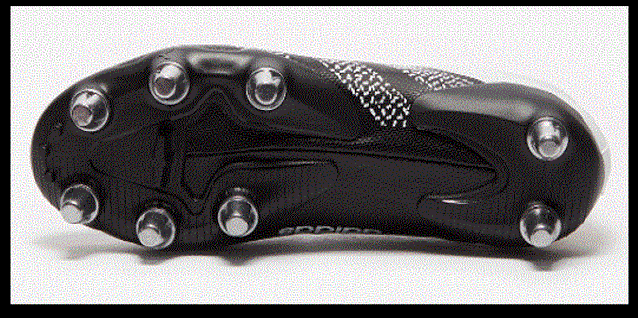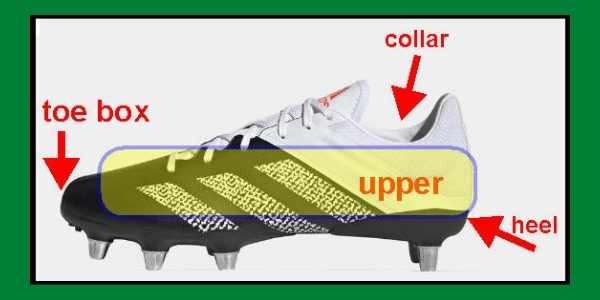Rugby cleats and American football cleats look similar and may seem interchangeable. But there are as many subtle differences between the two types of shoes as there are in the sports themselves.
Rugby players should be aware of the differences as each sport has its own rules and regulations. In particular, American football studs may be illegal in rugby.
What’s The Difference Between Rugby and American Football Cleats?
Rugby and American football cleats differ in three major ways:
- number and configuration of studs
- use of detachable, molded, screw-in studs
- ankle height of the boot
This article runs through each in detail.
Difference In The Number of Studs

One of the biggest differences is in the number of studs on each shoe.
Rugby players typically require 6 to 8 studs while American football players require 7 to 12 studs.
This is because of how long the ball is in play at any given time. For rugby, the ball is in play on average for 35 minutes, versus just 11 minutes for American football players.
Because the ball is in play for a longer period of time, rugby players tend to run more. In practical terms, this means they need a lighter shoe with less weight found in the cleats. Hence the smaller number.
Detachable Vs Molded Studs
A third difference between the two shoe types takes the form of studs. Studs are made of plastic or metal that are attached to the cleats.
In general, rugby players tend to play in a wider variety of conditions than their American Football counterparts.
Detachable studs in rugby
Depending on the time of day and the weather, the ground can be a major factor for which studs are used in a rugby match.
If the ground is wet and slick, a longer stud is needed for increased traction. If the ground is dry and hard, shorter studs are necessary.
This means that ruby players prefer to feature shoes that can have detachable studs. This ensures that players do not have to own and use two pairs of shoes with different types of studs.
You can read more about choosing boots for different surfaces in our article on firm ground and soft ground rugby boots.
Molded cleats in American football
Football players tend to prefer to wear only one kind of stud type: molded, plastic cleats. This is because they are appropriate for most grass environments.
Molded plastic cleats tend to provide better traction on artificial surfaces than their metal counterparts.
The length of the cleat allowed tends to vary by association. For example, High School cleat length tends to vary, while the NCAA does not allow cleats longer than half an inch.
Screw-in studs
Screw-in studs are allowed for both players, but the materials allowed are different according to the different rules for ruby and American football.
According to Rugby USA, the leading governing body of rugby in the United States, screw-in studs are allowed ONLY if they are made of the same material (i.e. being made of either plastic or metal).
The screw-in stud being made of two different materials is not allowed. Metal blades being used as cleats are not allowed.
Toe cleats
Toe cleats are allowed in rugby, so long as they follow the material rules above.

In the picture above, there is a cleat below the marked toe box.
Toe cleats with an off-set style (where the cleat is slightly offset from the middle of the toe portion of the shoe) are allowed as long as the screw-in stud is made from the same single material.
This can be either metal or plastic.
More about different materials
If you want to know more, check out our article on what rugby boots are made of.
Difference In Ankle Height
Another difference between them is the ankle height. While each player has their own personal preference, there are some generalities for each sport.
In general, rugby players prefer a lower ankle height because of the need to run, change direction, and jump at a moment’s notice.
This is in contrast to American football players, who tend to feature a wider variety of ankle heights in their shoes depending on the position they play.
Those who move more, such as a Running back or Wide receiver, tend to favor a lower ankle shoe.
This is in contrast to a Lineman, who wants a higher-ankle shoe for stability when charging other players at the line of scrimmage.
Can You Use American Football Cleats For Rugby?
You can use American football cleats for rugby as long as you follow these rules:
- The length of the cleat shall be no greater than 21mm.
- The radius of the cleat is no less than 1mm.
- The ends of the cleats are rounded and not flat in shape.
In the NFL, players are allowed to wear 1 inch (24.5mm) cleats in extreme conditions. This is considered an illegal length for rugby cleats.
Note that rugby referees will be checking all cleats worn out to the field before the start of play. Any players who do not comply with the stated rules will not be allowed to play. F
or more information on the rule regarding cleats for ruby players, the reader can check out the Rugby USA Protective Clothing Guidelines.
Why Is Football’s Single Toe Stud Now Allowed In Rugby?
You may see references on the internet to single-toe studs being illegal in rugby. The articles may talk about rugby players having to cut off the toe stud on their football cleats before taking to the field.
This was true up until recent years. Currently, single-toe studs are allowed.
Single toe studs banned from rugby in 1981

The historic problem with single-toe studs in rugby was with the old style of rucking (that is now illegal). Players used to be allowed to use their feet to rake the bodies and legs of opposition players on the ground at a ruck.
You’d often hear yells (from forwards) and squeals (from backs) in those old games. It was an effective way of preventing players from lying on the ball!
However, the single toe stud could cause deep lacerations and serious injuries when raking a body. So, the World Rugby authorities stepped in. They banned this configuration of studs in 1981.
Single toe studs become legal again in 2012

In 2012, the IRB changed its laws around stud configuration. Specifically, they approved a design from Adidas with the single toe stud configuration.
The official reason was that this improves the ability of back row forwards to scrummage! They get a better grip as they bend and push from the back of the scrum.
Many rugby commentators and supporters raised their eyebrows at this explanation for bringing this configuration back. I was one of them! I mean, such a big change for one position?
There was speculation that the change was to make rugby more popular in the United States. Allowing the configuration means that parents don’t have to buy different boots for their kids to play both rugby and American football.
Seems to be no increase in injury
Some medical professionals expressed concern about the return of the single stud. They were worried about a return to serious injuries.
However, I haven’t found any evidence to suggest that this has happened in the last ten years. And I think there’s a specific reason for that.
In my opinion, we haven’t gone back to the older days of injuries from studs because the World Rugby authorities have also cracked down on dangerous rucking.
Stamping in the ruck is now a red card and a lengthy ban from the sport.
Related Articles
- How to stretch your new rugby boots without damaging them
- How to clean your rugby boots without causing damage